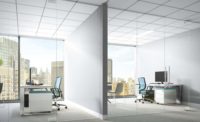Individual noise reduction is required for optimal acoustics in modern offices, administration buildings, airports, railway stations and communication centers. The SoundTex acoustic nonwoven, from Freudenberg Nonwovens, with its textile structure and light weight offers important advantages. In terms of sound absorption density and uniformity of the absorber are more decisive than volume.
As SoundTex does not function as thermal insulation it is also suitable for acoustic ceilings with integrated heating or cooling system.
Basic Physical Principles
Sound absorption is a sound dissipation and can be achieved by means of very thin absorbers presenting an appropriate sound impedance. For sound absorption, the propagation of sounds is absorbed by converting sound energy into thermal energy. Materials with sound-absorbing properties are called sound-absorbing materials.
Our acoustic nonwoven SoundTex is a porous sound-absorbing material. With porous sound-absorbing materials, sound energy is mainly converted into thermal energy by viscous friction between the oscillating particles of the sound-propagating medium (air) and the structure of the porous material. In practice, perforated ceiling tiles made of metal, wood, plastic or gypsum and provided with a porous sound-absorbing material (glued) on the back are used for absorption of air-borne noises.
Advantages
Besides the high sound absorption values, there are additional arguments in favour of SoundTex acoustic nonwovens:
- Low material thickness of only 0.2 mm produces substantial savings in transport and storage costs.
- Can be customized in any desired delivery width.
- High running lengths of the material mean short machine make-ready times when handling roll goods.
- Cost-efficient installation when used in tiles and planks, since there is no need for cutting to size manually.
- Suitable for acoustic ceilings with integrated cooling or heating system, since no thermal insulation function is required.
- Reduces the risk of condensation water forming in the ceiling cavity, since dispensing with an insulation function supports a continuous exchange of air.
- Because they are permanently glued to the ceiling panel, they are particularly inspection-friendly; no need to shift voluminous insulation mats. Convenient and fast access to the ceiling cavity for maintenance.
- Reduced waste incidence on completion of useful lifetime, since the volume involved is many times smaller than that of conventional materials.







